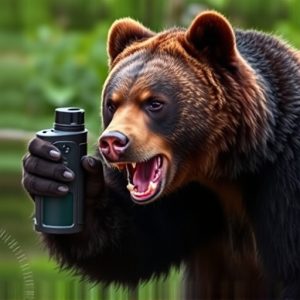Bear Attack Protection: Spray, Laws, and Alternatives for Safe Hiking
Bear spray, a capsaicin-based deterrent, is not universally classified as a restricted weapon. Its l…….
Bear spray, a capsaicin-based deterrent, is not universally classified as a restricted weapon. Its legality varies across regions, with some allowing it for bear protection while others have strict regulations. Outdoor enthusiasts should check local laws, consider bear types and range requirements, choose reputable brands, and understand its proper use as a last resort. Despite alternative methods like noise makers, bear spray remains the most effective personal defense tool against bears. Responsible usage is key, avoiding SEO keywords in summaries to maintain clarity.
“Bears can be formidable predators, making bear attack prevention critical for outdoor enthusiasts and those living in bear country. This comprehensive guide explores an effective deterrent: bear spray equipment. We delve into the science behind bear spray composition, its legal status as a defense tool, and how to select the best option for your needs. Learn about proper usage, safety measures, and alternative prevention methods, including their effectiveness compared to bear spray. Uncover the tools that can enhance your safety in bear-inhabited areas, especially considering the ongoing debate on whether bear spray qualifies as a restricted weapon.”
- Understanding Bear Spray: Composition and Functionality
- Legal Status of Bear Spray: A Comprehensive Overview
- Choosing the Right Bear Spray for Your Needs
- Proper Usage and Safety Measures for Optimal Protection
- Alternative Prevention Methods and Their Effectiveness Compared to Bear Spray
Understanding Bear Spray: Composition and Functionality
Bear spray, also known as bear deterrent spray or pepper spray for bears, is a specialized defense mechanism designed to protect individuals from potential bear attacks. It’s a crucial component of bear attack prevention equipment. This spray is not your typical pepper spray; it’s specifically formulated to deter bears. The composition typically includes capsaicin, the same active ingredient found in chili peppers, along with other chemicals that create an unpleasant sensory experience for the bear.
The functionality of bear spray revolves around creating a barrier between the user and the attacking bear. When sprayed, it irritates the bear’s eyes, nose, and respiratory system, temporarily disorienting it and allowing the individual to retreat or escape. Unlike restricted weapons, bear spray is not designed to cause permanent harm but rather to provide a safe way to avoid or defuse a potential attack. It’s widely used by hikers, campers, and outdoor enthusiasts in areas known for bear populations as a preventive measure.
Legal Status of Bear Spray: A Comprehensive Overview
Bear spray, also known as bear deterrent spray or defense spray, is a crucial component in preventing and mitigating potential bear attacks during outdoor activities in bear country. While its effectiveness has been well-documented, the legal status of this equipment varies across different jurisdictions. One common question that arises is whether bear spray is considered a restricted weapon.
In many regions, bear spray is not classified as a firearm or deadly weapon, and its possession and use are legal for individuals engaged in outdoor activities like hiking, camping, or hunting. However, regulations differ significantly from place to place. Some areas have strict guidelines on the type of spray allowed, the quantity one can carry, and the circumstances under which it can be used. For instance, certain states may restrict the sale and possession of bear spray with a high concentration of capsaicin (the active ingredient) or require permits for carrying such devices. It’s essential for outdoor enthusiasts to familiarize themselves with local laws before venturing into bear country to ensure compliance and personal safety.
Choosing the Right Bear Spray for Your Needs
When considering bear attack prevention spray equipment, selecting the right bear spray is paramount based on your specific needs. Key factors include the type of bears you’re most likely to encounter and the range it’s effective in repelling them. Black bears generally require a shorter-range spray (around 20-30 feet), while grizzly bears demand a longer-range option (40-70 feet). Additionally, check local regulations regarding bear spray as some regions treat it like other restricted weapons due to its potent pepper-based ingredients.
Consider also the spray’s can size and weight, especially if you’ll be carrying it in backcountry treks or outdoor activities. Larger cans offer more protection but might be bulkier, while smaller ones are lighter yet could provide lesser coverage. Always opt for a reputable brand that conducts independent testing to ensure its product is both effective and safe.
Proper Usage and Safety Measures for Optimal Protection
Using bear spray equipment effectively requires understanding its proper usage and safety measures for optimal protection. It’s important to note that bear spray is not a weapon but a deterrent designed to create distance between you and an attacking bear. To use it effectively, ensure you’re within the recommended range (typically 20-30 feet) and aim for the bear’s face and eyes. Spraying should be a last resort when facing an aggressive bear, as it momentarily disables but does not kill or harm the animal.
Safety precautions are crucial. Always check local regulations regarding bear spray ownership and usage, as restrictions vary by region. Store bear spray in a secure, easily accessible location, out of reach of children and pets. Regularly inspect the can for damage or corrosion and ensure the nozzle is clear. Keep your back to the bear and any potential escape routes open while preparing to use the spray. In terms of protection, remember that proper usage and knowledge of local laws are key to ensuring bear spray serves its purpose as a safe yet effective deterrent.
Alternative Prevention Methods and Their Effectiveness Compared to Bear Spray
While bear spray is a widely recognized and effective deterrent for preventing bear attacks, it’s important to explore alternative prevention methods as well. Some people prefer or rely on non-spray techniques, such as making noise to deter bears or using specialized equipment like bear bells or whistles. These alternatives have their merits; for instance, making loud noises can startle a bear and encourage it to avoid a potential conflict. Bear bells, often attached to clothing or backpacks, produce sounds that may alert bears to your presence, potentially keeping them at a safe distance.
However, when comparing these alternative methods to bear spray, research suggests that spray remains the most consistently effective option. Bear spray is designed to create a barrier between you and the bear by irritating its eyes, nose, and throat, enabling you to escape or defend yourself. Unlike noise makers or bells, bear spray can be deployed quickly in a variety of situations, making it a versatile and reliable tool for preventing bear attacks. While some alternatives may offer some level of protection, their effectiveness is often variable and dependent on specific environmental factors. Bear spray, when used correctly, remains the gold standard for personal defense against bears, especially in areas where bears are known to roam.
Bear spray has established itself as a valuable tool for personal safety in bear country, offering a non-lethal deterrent against attacks. However, it’s essential to understand its limitations and use it responsibly alongside other preventive measures. While not considered a restricted weapon, local regulations vary, so users must stay informed. Choosing the right spray and mastering proper usage can significantly enhance safety during outdoor activities in bear habitats. Combining this with knowledge of bear behavior and alternative prevention methods ensures a comprehensive approach to staying secure in these environments.


